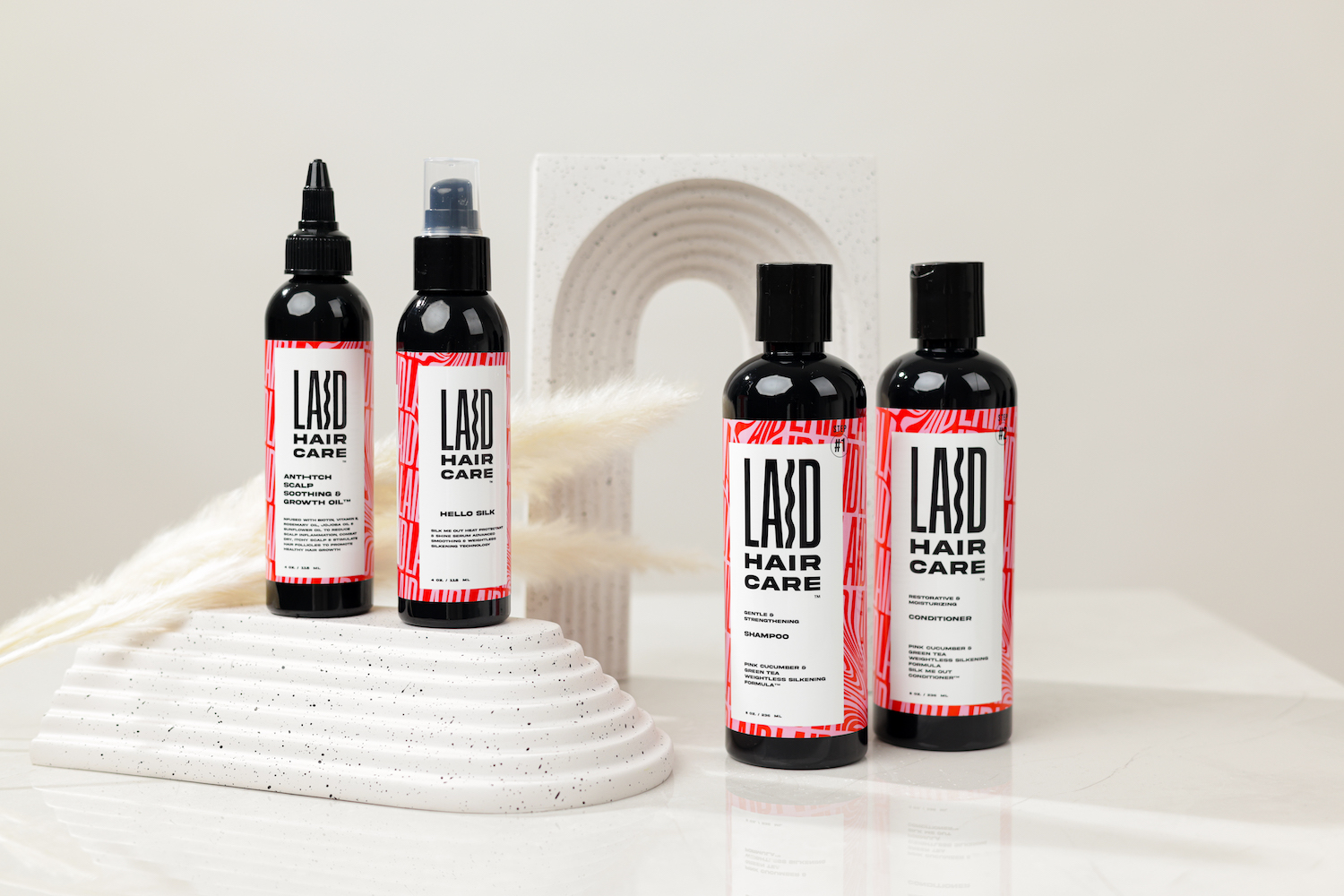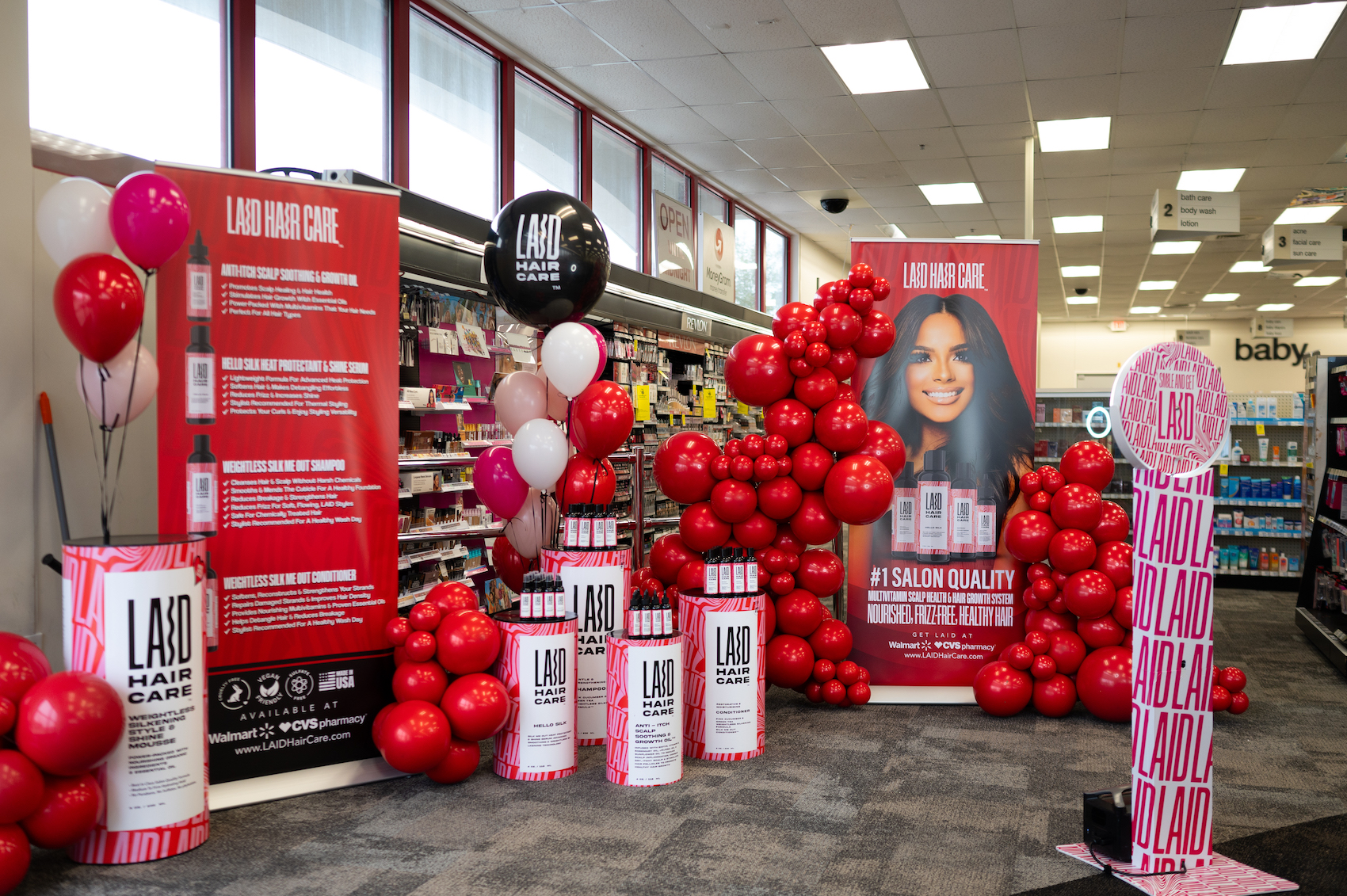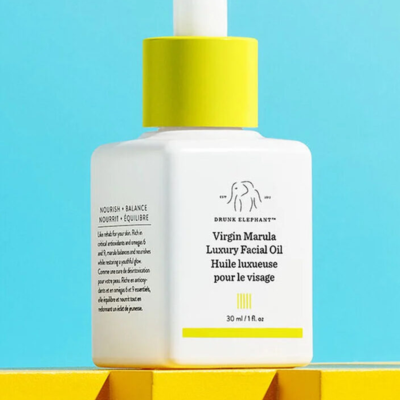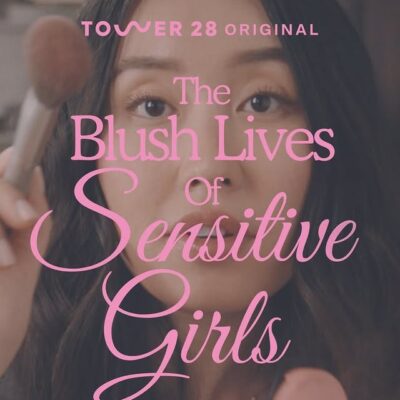
Meet The Entrepreneur Bringing The Beauty Supply Experience To Walmart Stores
Laid Hair Care founder Kaylah Joseph wants to help get people laid at Walmart—and she’s not in the business of encouraging anything NSFW. Instead, she’s setting up beauty supply shops inside the megachain’s stores, where shoppers can buy wigs, extensions and so much more to make sure their hair is impeccably laid.
Called Laid Beauty Bar, Joseph’s beauty supply concept has already entered its first Walmart store in her hometown of Huntsville, Ala. Her dream is for it to expand to 100 locations within the next decade. And Joseph isn’t afraid to do what it takes to turn her dreams into reality.
Case in point, when she was rejected from Walmart’s accelerator program in 2022, she reached out to the retailer to ask how she could improve to be accepted to it in the future. Her outreach opened up a conversation with a buyer that eventually led to Laid Hair Care rolling out to 941 Walmart doors. The brand is also stocked at 563 CVS doors. Its doubled retail sales since 2023 and is on track to quadruple annual sales this year.
Laid Hair Care is known for its bestselling Anti-Itch Scalp Soothing Growth Oil. Its product lineup stretches beyond the bestseller to the products Weightless Silk Me Out Conditioner, Weightless Silk Me Out Shampoo and Weightless Silkening Heat Protectant & Shine Serum. It’s not in the lineup now, but Joseph started the brand in 2019 with a glue product.
“I do a lot of protective styles, and one time my hairline broke out so badly that I created a wig glue that worked much better,” she explains, mentioning she plans to soon pitch the product and a wig install product range to Walmart.
Ahead, we chat with Joseph about Laid Hair Care and Laid Beauty Bar’s beginnings, the reasons why she’s placing beauty supply stores in Walmart, the major costs of launching at major retail, the difficulties of driving sales via social media today and her vision for a different kind of partnership for her brand.
How did you get involved in beauty?
The short version of a really long story is that my hair fell out. I went and got my blood tested, I got steroid shots, I got a whole bunch of things because I just knew something was wrong. I realized that the reason why my hair was falling out was I was having an allergic reaction to the products on my scalp. They included heavy greases and butters. I was using the products for years, but sometimes you’ll develop allergies or they’ll change product ingredients.
Once my hair started falling out, I started using other products. I was using serums, taking biotin, and I wasn’t seeing improvement. I started mixing stuff up—rosemary oil, jojoba oil—and I was sourcing them directly from vendors, not the store-bought version. My hair started growing back. Then, I realized a lot of my friends were experiencing hair loss during the pandemic, too. They were like, if you grew your hair back, let us try this.
At what point did you decide to start a brand?
My friends start telling other people about it, and somehow the beauty supply stores in my area found out about my product. They were calling it Laid crack. They called me, and they’re like, “Hey Kaylah, do you want to put your product in my store?”
I get my product tested in a lab, and they tell me it’s good. I get it certified, I’m passing all of the tests. We get our safety data approval, then I get insurance on it. I say OK to the beauty supply company. I made little labels on Canva and put them on the product. We called it Laid Oil.
I get into the beauty supply stores, and they start selling out. They’re like, “Kaylah, we can’t keep this on our shelves.” I was like, “I have another job, so I’m not really sure what you guys are going to do about this because I’m only making this in small batches.” They’re like, “I really think that you’re onto something here.”

When did you consider retail beyond beauty supply?
I applied to Walmart’s accelerator program in 2022, and I get declined. I got declined from Target the year before. When I got rejected from Walmart, I was feeling disempowered. I sat on that email for about 48 hours, and then I replied. I was like, “Thank you so much for taking the time to review my application. It is a little disheartening to not only get rejected, but to not know what you actually did wrong so that you can correct it in the future. Thank you for all that you guys do, and I hope to learn how I can become part of Walmart’s team in the future.”
I get a reply from the buyer a day later, and it’s like, “Kaylah, I’ve been there, I know what that feels like. Let’s set up a conversation to talk.” It was a defining moment that not only were my experiences validated, but she humanized the situation. We get on the phone, and she’s saying these are the things that we look for in products and capabilities, and these are the areas where your application wasn’t necessarily the strongest. As she’s talking, I’m taking extensive notes.
She’s like, “We may do line reviews in a couple months, and we can circle back then.” I’m like, OK, I’m five years closer to my goal of getting into retail. After I got off the phone with her, I made changes. A couple of months later, I get an email, and it’s like, “Hey, we’re getting ready for line reviews in a couple of weeks, do you think that you want to present?”
I’m super nervous about my presentation. I’ve never done a line review before. I don’t know anyone personally who would’ve been able to give me advice on it, but she’s like, “It seems like you’re in a better position to do this now. I really like your story. I like your brand. How many stores do you think that you would be able to be in?”
How did talks for the Laid Beauty Bar come about?
As I got on shelves in Walmart, I mentioned very casually, “You know what I think Walmart is missing? This is kind of separate from my existing business, but Walmart is missing wigs, weaves and extensions.” She was like, “We tried to put them on the aisle, and they’re doing well, but we need to figure out how to do it better.”
I said to her, “You can’t put a hair extension product that’s expensive on the aisle in Walmart because they require a conversation.” Even white women have a conversation with their hairstylist about hair extensions. Black women have a conversation with their friends before going into the store. While they’re there, they’re having another conversation with their friends, then they’re asking the girl at the counter.
I was like, “Walmart’s issue isn’t that they don’t have the customer, they don’t have the beauty experience, and you guys are located in these communities that buy hair extensions at high rates, but they don’t have anyone who looks like us. One thing I would hate for Walmart to do is to gentrify the extension wig and weave space and not include Black women.”
A couple months go by and she brings up the conversation with her boss, the real estate team and the licensing team. They’re like, “Kaylah, do you have the capital to back this?” We also have a manufacturing company that supplies parts to Toyota and Mazda, so I’m not saying capital isn’t an issue, but capital would be the least of the problems. The problem would be making sure that Walmart understood the mission of what I was doing. I told them, “I want to do 100 locations in 10 years.”
After that conversation, we got approval. Now, we’ve opened our doors in Huntsville, Alabama for location No. 1, and No. 2 and No. 3 are already under construction. We’re bringing the beauty supply store experience into Walmart. Not only will we have wigs, weaves and extensions, we’re also offering other indie brands.
Laid Hair Care products will obviously be in the store. There’ll also be more protective styling options and options for people experiencing hair loss. There’ll be scalp health brands, professional salon care options, hair extension options, bonnets, just additional options that serve our community in a new way.
Are the brands in the supply store also on Walmart shelves?
Most of the brands are currently in retail, but some of them are not in Walmart. We have Design Essentials, which is more of a professional high-end line, but we also have Redken products as well. Walmart is a partner in this process, so they get a percentage of all sales. My store is at the front of the store. If you want to just run in and out and don’t want to walk all the way to the beauty aisle, you can just grab the products.
We’re able to incubate new brands. Let’s say there’s someone I’m seeing on social media, and I’m like, wow, I would love to carry their products and maybe they have an ultimate goal of going into retail. I’m saying, hey, put your products in here first and see how they do.
What did you do before launching Laid?
I was actually working at a wig, weave and extension store. I was managing their entire backend. I was dating someone, and his family business was a wig, weave and extension store, and they just had it as a mom-and-pop business. Well, I scaled it.
When I originally planned on getting into Walmart, we were going to do it together, but we broke up and ended up saying we can’t work together.
How did you finance Laid in the beginning?
With the hair glue, that was probably less than $3,000. I spent most of that on the chemist giving me the formula to make the glue. When it came to Laid haircare, I was probably like $75,000 in. The bulk of the money I ended up investing came once I started considering getting into Walmart. Before then, we probably spent maybe $10,000 maximum, and that was on bottles, formulations, bulk storage warehousing, Shopify. Money that I spent was already generated by the brand. So, it wasn’t necessarily an additional investment.
What took money was when I decided to get into retail. Retail margins are not the same as direct-to-consumer. I was splitting my profit with Walmart and then also having to increase my marketing spend significantly, having to hire warehouse employees because of how much we were shipping to them weekly. Before we even turned a real profit on the Walmart account, I was probably about $350,000 in.
Have you raised money?
No. I do want to do a round of venture capital funding, but I don’t want a horror story. I’m a person who really lives a calm life. I’m in Huntsville, Alabama, we’re not a flashy city. I don’t have a point to prove.
When you take on investor funding, you have to increase your marketing spend, and what do people want to see in your marketing? They love the flashy, and that is so not my personality at all. I don’t think that the flashy is what sells products. It is not what gives you longevity.
“I don’t think that the flashy is what sells products. It is not what gives you longevity.”
Can you talk about the manufacturing company you own?
One of the manufacturing companies I worked with, their timelines were too long, they couldn’t keep up with retail, and they weren’t making the product the way that I liked.
Now, we just do it all in my facility, and we do it here so that not only can we monitor it, but we can also control cash flow a lot better. I don’t have to necessarily spend $300,000 on an order to meet the minimum order quantity, I can literally just run my machine once or twice a week.
In a LinkedIn post last year, you mentioned that you wanted to take a step back from social media and that consumer conversations on social media platforms don’t necessarily equal sales. What’s your relationship with social media now?
I’m reworking it because a lot of what used to work does not work anymore. During the pandemic, almost every company had record sales. People were home scrolling and had extra money. During the pandemic, we could talk about scalability.
Now, customer acquisition costs are so high, and there’s no brand loyalty. People are buying a product once, loving it and never buying it again because, by the time that they even think about buying it, there’s another product on the market to try.
I am moving back into what I am best at, which is why I’m opening Laid Beauty Bars, which don’t necessarily require additional conversation. I’m putting my store inside Walmart, which is already heavily trafficked. I’m giving people the option of having products that they are already familiar with.
The beauty supply stores are what will build longevity because I don’t have the capital to support the marketing spend. We are really in that time period of advertising where your marketing spend is just how much can you pay to go viral. You can pay $250,000 to go viral on TikTok, you can pay to be viral on Amazon, but people talking about your product is no longer enough for them to buy your product. They have too many options in the marketplace.
You have to go through 10 sponsored ads before you even see my product. People don’t realize that’s going to hurt small businesses because we can’t keep paying, paying, paying to be sponsored ads. We’re still competing against the Procter & Gambles, the L’Oreals.
So, you’re still figuring it out?
Yeah and just letting the sales nurture my existing community already purchasing. My online sales have not plummeted, so that’s one of the things about retail that’s shown me a different perspective. My online prices are double my retail prices, and my online customer has not left me, which honestly goes against the data.
In retail it’s like, Kaylah, you’re not having as many sales as maybe another brand that’s next to you. I’m sitting there like, well, you guys have me in the corner on certain areas, at the bottom of this shelf. People can’t see me. My product is one of the higher priced products on the aisle. My online customer are Black women who are buying my products, my in-store customer are white women and men. It’s like, what do you want from me?
My customer online is not my customer in the store, but I cannot spend money marketing to the customer that’s in the store because then I’m competing against Suave and Herbal Essences, which already have the white customer, and they’re going to spend more money on it. If I start putting my social media marketing budget toward highlighting the white customers who are buying my products in the stores, then my Black customers who are online are going to now think, “This isn’t for me.” It’s a dichotomy that’s really hard to keep explaining.
How do you think about expanding Laid’s product collection?
I think you should get better before you get bigger. I have a styling line. It’s six products, and I have it on ice. I don’t want to run into what I’ve seen a lot of brands do where they move across the category and their customers now switch from buying their core products to their secondary line instead of attracting new customers to try multiple products.
Then, I have to consider, if I’m having certain in-store retail issues, me spending another $350,000 for manufacturing to be able to stock these in stores with the original initial order, when am I going to see the ROI on that?
I haven’t made a decision on how I’m going to grow across the category, especially because, now that I have the beauty supply stores, I almost can take a complete step back from competing for shelf space. I know that I can do much better in the retail beauty supply store store space than maybe I can do online competing with marketing expense.

What’s Laid’s future distribution strategy?
I am still figuring that out. We did our line review with Target, and this was a more strategic line review. I used to be that person who’s like, I want to get in all the stores, but I have talked to Target about doing something very different. I asked for only 50 stores and asked for an end-cap, which is so different from the 941 Walmart stores and 536 CVS stores. I’m like, put me where I will do well and give the customers that opportunity to get to know me and my brand.
I really love how Target does the “meet the founders” on the aisle. I love how Target has such a small category lineup so that you don’t feel overwhelmed. That allows the suppliers to feel like they’re filling up more of the space. So, maybe instead of four of each product or 10 of each product that they’re putting on the aisle, you’re seeing Target carry 20 of each product, which is taking up the shelf, but it’s also limiting the competition that you have. You’re giving indie brands an opportunity to be competitive.
I don’t necessarily feel like I’m able to compete in Walmart. It’s not because they’ve done anything wrong, it’s because they’ve done so much right for their brands where they really have said, OK, we need to make this amount per inch on our aisle, so we need to give everybody the opportunity to drive their customer to this one space. It’s a method that works for them and for larger brands, and I’ve seen it work for a few smaller brands, but I’m just trying to adjust.
What are some short-term and long-term goals you have for Laid?
My short-term goal is obviously to get Laid Beauty Bar to hit the road and get No. 2 and No. 3 open. My long-term goal is a round of investor funding. That may be not only capital, but expertise in the marketing space or a collaboration between me and one of the larger brands.
I would love it if Procter & Gamble or Johnson & Johnson said, “Hey Kaylah, we want to invest, but we want to invest in a way that works for you. What if we partnered on a specific line so that we don’t necessarily have to take equity, but we will get a portion of these sales because you are using our branding?” Please allow me to create a legacy company in a different way that allows us to be allies and not competitors.
This interview has been edited for clarity and brevity.





Leave a Reply
You must be logged in to post a comment.